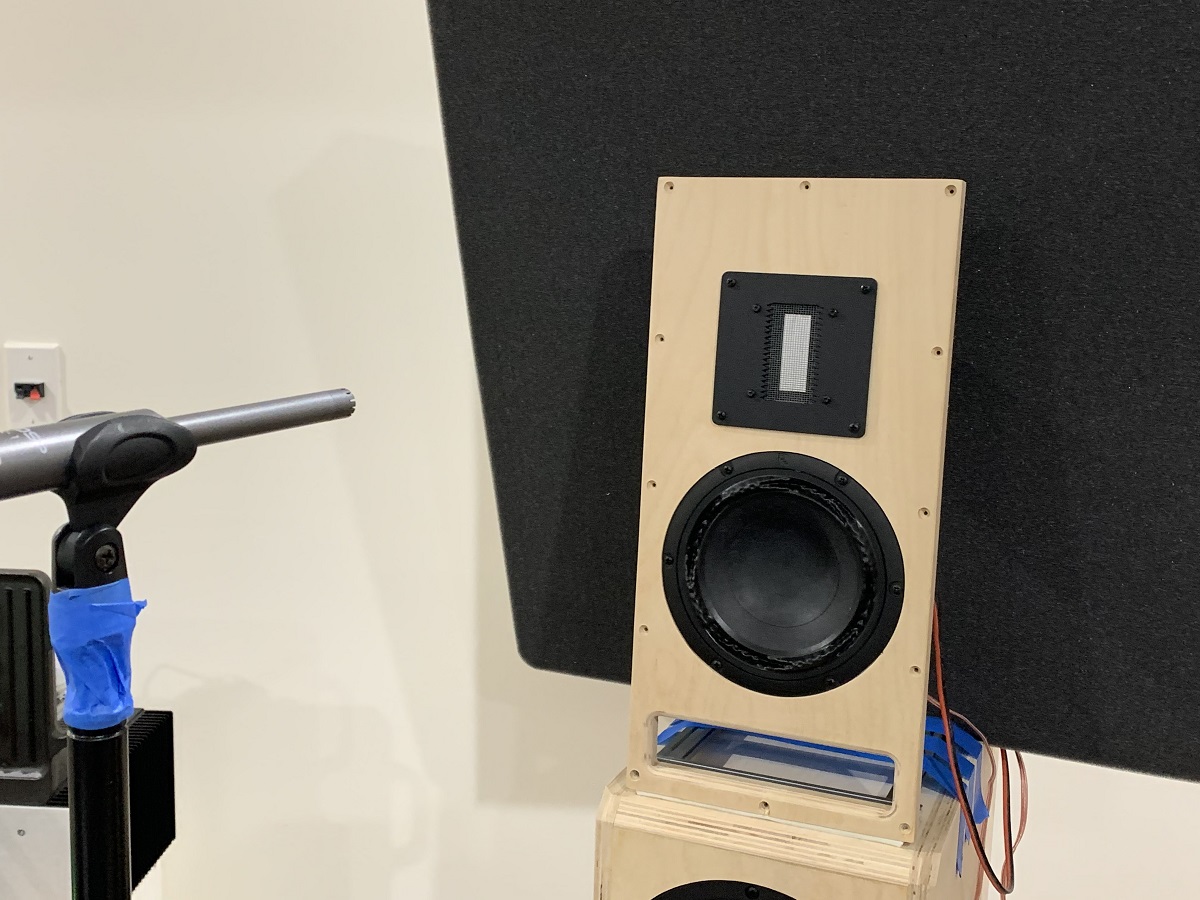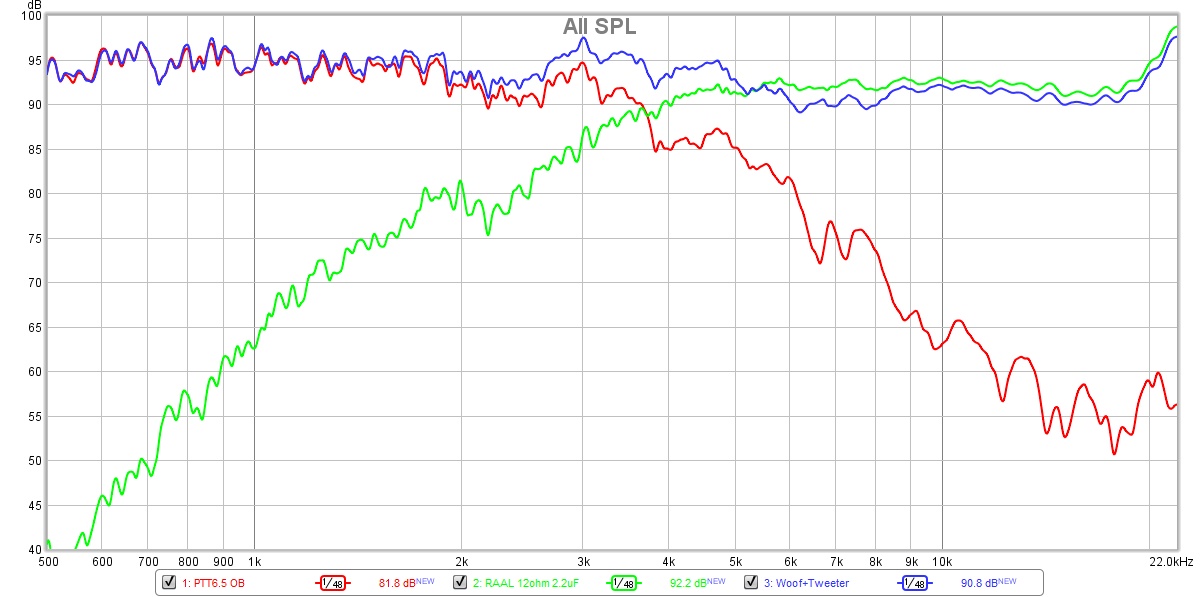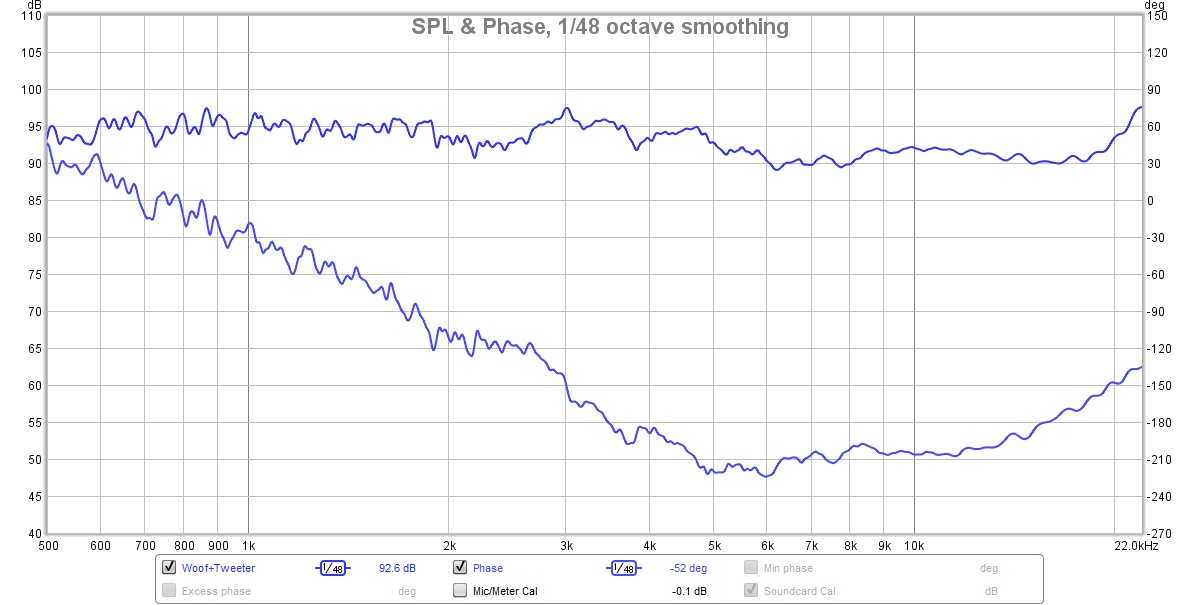HI Gents,
I ran across a review of the Triangle Titus 200 mini monitor: (Product Review ) which said it sounded great and used only a single capacitor as a crossover.
I love building speakers and have built some with 9 or more components in the crossovers which sounded very good, but am wondering if it is possible to substantially reduce the number of components and still get very good sound. If anyone is aware of a proven design that is small (10L or less ) and has a 3 component or less crossover, I would greatly appreciate hearing about it.
Thanks!
Jay
I ran across a review of the Triangle Titus 200 mini monitor: (Product Review ) which said it sounded great and used only a single capacitor as a crossover.
I love building speakers and have built some with 9 or more components in the crossovers which sounded very good, but am wondering if it is possible to substantially reduce the number of components and still get very good sound. If anyone is aware of a proven design that is small (10L or less ) and has a 3 component or less crossover, I would greatly appreciate hearing about it.
Thanks!
Jay
There is plenty of B&W designs incorporating 3 passive parts for a crossover. CM1 for instance. Higher priced range of 2 way speakers of this brand also. Have a listen and decide for yourself. I think that we have discussed this approach more than enough in order not to repeat ourselves, imo.
It can be done but you must know what you are doing, and it is the choice of woofer, tweeter etc. That makes it possible.
If you are going to cross a tweeter with just one cap, you would need to do it at a higher frequency, something to the tune of 6kHz onwards. And probably a tweeter with a reasonably high excursion.
You would choose a woofer that goes up to that frequency and rolls of nicely without break up that emits all kinds of nasties.
You can't overlap the tweeter and woofer, in other words a full range speaker, both playing the same thing. The issue is the softer one will become the "distortion " for the louder one.
Oon
If you are going to cross a tweeter with just one cap, you would need to do it at a higher frequency, something to the tune of 6kHz onwards. And probably a tweeter with a reasonably high excursion.
You would choose a woofer that goes up to that frequency and rolls of nicely without break up that emits all kinds of nasties.
You can't overlap the tweeter and woofer, in other words a full range speaker, both playing the same thing. The issue is the softer one will become the "distortion " for the louder one.
Oon
Last edited:
Great sound from a 2-way tweeter + woofer with a simple passive crossover circuit often starts with driver time alignment from a stepped baffle cabinet or a proper depth tweeter waveguide. A +LR2 circuit using L + C passives on the woofer, and a reverse phase -LR2 circuit using a C + L passives on the tweeter combine for good phase alignment through the crossover frequency. A series resistor on the tweeter balances SPL differences. A slanted baffle can also provide time alignment, but only at one listening distance - many 2-way require flexible placement on desks or in several different rooms.
Thanks for the input so far. I guess I should have emphasized the last sentence by putting it first instead of referencing an old review. What I was trying to find out is if someone is aware of a good sounding DIY design that is small (10L or less ) and has a 3 component or less crossover. I would like to build something like that but don't know of any published design that meet those criteria. Sorry to have not been clearer!
Jay
Jay
As we as mentioned, it depends on the drivers. They can sometimes have natural roll offs that permit virtually just 1 or 2 components on the XO.
I ran into such a case when I was just measuring raw driver in cabinet data for designing a crossover. I only put a 2.2uF high pass cap on the ribbon tweeter to protect it from DC (a cap is mandatory as it has a low impedance inductor internal to the tweeter). So 1 component. The woofer was running full range. Here was the resulting raw data plot of just the woofer, tweeter and combined system with a single 2.2uF cap.


Here is measured acoustic phase:

Of course, these are both SOA drivers in their category: Purifi PTT6.5 woofer and RAAL 70x20xr ribbon tweeter.
RAAL 70-20xr and PTT6.5 Compact TL
So sometimes it’s just plain luck.
I ran into such a case when I was just measuring raw driver in cabinet data for designing a crossover. I only put a 2.2uF high pass cap on the ribbon tweeter to protect it from DC (a cap is mandatory as it has a low impedance inductor internal to the tweeter). So 1 component. The woofer was running full range. Here was the resulting raw data plot of just the woofer, tweeter and combined system with a single 2.2uF cap.
Here is measured acoustic phase:
Of course, these are both SOA drivers in their category: Purifi PTT6.5 woofer and RAAL 70x20xr ribbon tweeter.
RAAL 70-20xr and PTT6.5 Compact TL
So sometimes it’s just plain luck.
I believe it's minimum phase.Can you explain the phase to me on that 2 way ?
0 degrees to -210 ?
not what I recognize looking at dunlavy stuff on stereophile
Dunlavy Audio Labs Signature SC-VI loudspeaker Measurements | Stereophile.com
not what I recognize looking at dunlavy stuff on stereophile
Dunlavy Audio Labs Signature SC-VI loudspeaker Measurements | Stereophile.com
so, the highs and lows are still moving around forward and backward, compared to a tight phase plot ?
Not sure what you mean by highs moving around. This phase plot is rather flat with a 55deg hill. Look at phase plot of an LR2 or LR4 and they wrap through 360deg, sometimes, multiple times.
True, 55 degrees is good, especially compared to steeper crossovers that are all over the place.
As far as I knew, the phase changing is also changing the relative distance of that driver at that frequency.
I’m fuzzy on this stuff but I can throw up some stuff from green mountain audio roasting a 24db lr crossover. Got to find it.
As far as I knew, the phase changing is also changing the relative distance of that driver at that frequency.
I’m fuzzy on this stuff but I can throw up some stuff from green mountain audio roasting a 24db lr crossover. Got to find it.
Last edited:
from Roy johnson (Green Mountain Audio)
"If a speaker uses a 4th-order crossover at 3,000Hz (common for a 1" tweeter), what will we actually hear from this system?
*
Down at 1,500Hz, the tweeter isn't really contributing. Thus, the image is formed by the woofer. However, the woofer moves back by one inch because the circuit imposes 75 degrees of shift at 1,500Hz. But the dimensional shift is always relative to that 3,000Hz wavelength reference point, where (75 degrees/360) x (13,500ips/3000Hz) = 1 inch.
*
At 2,000Hz, the tweeter output is now audible (12dB softer then the woofer). We hear the image from the woofer move back by a little more, to 1.1" (90-degrees of 3,000Hz equals ¼ wavelength). Yet the tweeter is actually forward by 3/4ths of a wavelength of 3,000Hz, or 3.4". As a soprano's harmonics move through this region, we'll hear the image begin to split by 4.5" total. The image will begin to diffuse from front-to-rear, and harmonics structures will begin to fuzz over -- the sound will become grainy.
*
At 3,000Hz, the woofer and tweeter contribute equally. However, the woofer image has moved backwards by 2.25", for the same total split of 4.5". At this point, the image is very confusing and textures are at maximum graininess. The voice is split into two parts -- 'esses' and 'tees' from the tweeter arrive first, stretched out from the sound of the throat as delivered by the woofer -- an unnatural occurrence. The voice hisses and spits, and strings are edgy*. There'll be comments such as "the transients are etched..." "...detail thrust at the listener..." "...this speaker seems very fast..." "...analytical..." and "...very sensitive to electronics...." Of course, these comments would be expected because the tweeter arrived first!
* Not all higher-order designs sound like this, because there are ways to disguise the problem. Again, if the designer tunes the "Q" of the circuit (computer-optimized, or by ear), or otherwise misaligns the actual crossover point, the graininess will be reduced, along with transient response. The spatial distortion remains, however, and even a solo flute can be heard to wander.
*
At 5,100Hz, the woofer is now 12dB softer than the tweeter -- just audible. It's now 3.4" behind the tweeter's highest frequencies, and the tweeter is still 1.1" ahead -- a 4.5" total split.
*
At 12,000Hz, two octaves above the crossover point, the woofer output is non-existent, but the tweeter output will still arrive 30 degrees ahead (0.4 inches) of its very top end at 24,000Hz, where phase error returns to zero. This will disturb the timing of a wooden stick striking a bell, blurring its image. A musician striking the bell .4" late is definitely behind the beat as well."
and
"So, why use a first-order filter?
That Phase Difference remains Constant for a first-order filter: The output from the two halves of a first-order filter are always 90 degrees apart, on every frequency, not just at their crossover frequency. So their Relative Change in Phase Difference, at every frequency, is zero."
and
"You're right. I oversimplified. Actually the two drivers are 90 degrees out of phase on every tone (at least that's the goal), so the summation at every frequency has a constant relationship- there is no relative phase shift between the two drivers. The group delay is constant."
"If a speaker uses a 4th-order crossover at 3,000Hz (common for a 1" tweeter), what will we actually hear from this system?
*
Down at 1,500Hz, the tweeter isn't really contributing. Thus, the image is formed by the woofer. However, the woofer moves back by one inch because the circuit imposes 75 degrees of shift at 1,500Hz. But the dimensional shift is always relative to that 3,000Hz wavelength reference point, where (75 degrees/360) x (13,500ips/3000Hz) = 1 inch.
*
At 2,000Hz, the tweeter output is now audible (12dB softer then the woofer). We hear the image from the woofer move back by a little more, to 1.1" (90-degrees of 3,000Hz equals ¼ wavelength). Yet the tweeter is actually forward by 3/4ths of a wavelength of 3,000Hz, or 3.4". As a soprano's harmonics move through this region, we'll hear the image begin to split by 4.5" total. The image will begin to diffuse from front-to-rear, and harmonics structures will begin to fuzz over -- the sound will become grainy.
*
At 3,000Hz, the woofer and tweeter contribute equally. However, the woofer image has moved backwards by 2.25", for the same total split of 4.5". At this point, the image is very confusing and textures are at maximum graininess. The voice is split into two parts -- 'esses' and 'tees' from the tweeter arrive first, stretched out from the sound of the throat as delivered by the woofer -- an unnatural occurrence. The voice hisses and spits, and strings are edgy*. There'll be comments such as "the transients are etched..." "...detail thrust at the listener..." "...this speaker seems very fast..." "...analytical..." and "...very sensitive to electronics...." Of course, these comments would be expected because the tweeter arrived first!
* Not all higher-order designs sound like this, because there are ways to disguise the problem. Again, if the designer tunes the "Q" of the circuit (computer-optimized, or by ear), or otherwise misaligns the actual crossover point, the graininess will be reduced, along with transient response. The spatial distortion remains, however, and even a solo flute can be heard to wander.
*
At 5,100Hz, the woofer is now 12dB softer than the tweeter -- just audible. It's now 3.4" behind the tweeter's highest frequencies, and the tweeter is still 1.1" ahead -- a 4.5" total split.
*
At 12,000Hz, two octaves above the crossover point, the woofer output is non-existent, but the tweeter output will still arrive 30 degrees ahead (0.4 inches) of its very top end at 24,000Hz, where phase error returns to zero. This will disturb the timing of a wooden stick striking a bell, blurring its image. A musician striking the bell .4" late is definitely behind the beat as well."
and
"So, why use a first-order filter?
That Phase Difference remains Constant for a first-order filter: The output from the two halves of a first-order filter are always 90 degrees apart, on every frequency, not just at their crossover frequency. So their Relative Change in Phase Difference, at every frequency, is zero."
and
"You're right. I oversimplified. Actually the two drivers are 90 degrees out of phase on every tone (at least that's the goal), so the summation at every frequency has a constant relationship- there is no relative phase shift between the two drivers. The group delay is constant."
Last edited:
Hi again Guys,
At the risk of sounding like a broken record, is someone is aware of a published design for a good sounding DIY speaker that is small (10L or less ) and has a 3 component or less crossover?
At the risk of sounding like a broken record, is someone is aware of a published design for a good sounding DIY speaker that is small (10L or less ) and has a 3 component or less crossover?
I suspect ear and brain detects the difference in phase from two different drivers that are relatively close together not with delay but as SPL per frequency = frequency response, no?🙂 Unless the difference is few milliseconds.
Moreover, with IIR filters and delay it seems to be possible to align phases of drivers pretty well with at least an octave above and below the crossover frequency. Needs much more parts than 3 though, or one DSP 😉 Attached 3 way prototype speaker, which seemed to yield smoothest curves all round when phases of the drivers track each other closely. It is quite many parametric filters with DSP though. I don't know what name + order the acoustic crossover slopes are but it is few 1st and 2nd order filters, effect of the PEQ filters and the drivers natural roll off. Anyway, good drivers and modest SPL requirements are needed for few component crossovers it seems.
Moreover, with IIR filters and delay it seems to be possible to align phases of drivers pretty well with at least an octave above and below the crossover frequency. Needs much more parts than 3 though, or one DSP 😉 Attached 3 way prototype speaker, which seemed to yield smoothest curves all round when phases of the drivers track each other closely. It is quite many parametric filters with DSP though. I don't know what name + order the acoustic crossover slopes are but it is few 1st and 2nd order filters, effect of the PEQ filters and the drivers natural roll off. Anyway, good drivers and modest SPL requirements are needed for few component crossovers it seems.
Attachments
Last edited:
Don't hold your breath as there aren't many out there. Possibly a small woofer with a nice roll off such as the SEAS W12CY03 with an OEM RAAL could work with only 3 parts.Hi again Guys,
At the risk of sounding like a broken record, is someone is aware of a published design for a good sounding DIY speaker that is small (10L or less ) and has a 3 component or less crossover?
The easiest way to do this is with Woofer assisted wideband design, crossed over at the baffle step frequency. One inductor on the woofer, one cap on the wide band driver, and perhaps a level matching resistor. For the woofer, use a well behaved paper or poly driver -SB & Peerless come to mind, with something like a Vifa TG9 or Dayton PS95. For a box under 10L you're probably limited to drivers 5" or smaller
- Home
- Loudspeakers
- Multi-Way
- Small two way speakers with 3 or less crossover components.
